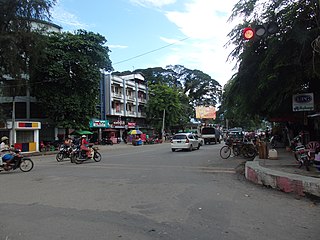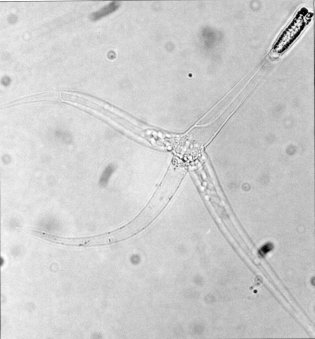
Dario sp. 'Myanmar' is a small growing, attractively patterned fish, a relative of the more well-known Scarlet Badis found originating in Northern Myanmar (Burma) found in shallow, slow-moving waters.

Dario sp. 'Myanmar' is a small growing, attractively patterned fish, a relative of the more well-known Scarlet Badis found originating in Northern Myanmar (Burma) found in shallow, slow-moving waters.
Dario sp. 'Myanmar' is probably endemic to northern Myanmar and possibly to the state of Kachin, close to the city of Myitkyina. A pair of males from separate localities were included in the type series of D. hysginon (see ‘Notes’)[ moved resource? ] with details given as ‘stream about 1.5 km on road Myitzon-Myitkyina’ and ‘ditch marginal to fish ponds about 40km N Myitkyina, on road to Myitzon’. [1]
No details are available but the possibly sympatric Dario hysginon shows a marked preference for small, often murky pools with dense growths of aquatic plants or submerged grasses. [2]
Dario species are micropredators feeding on small aquatic crustaceans, worms, insect larvae and other zooplankton. In the aquarium hobby, it is advised to feed them a varied diet of Artemia nauplii, Daphnia , grindal, microworms, and banana worm. [2]
Dario sp. 'Myanmar' is a substrate spawner forming temporary pair bonds. [2]

Trout is a generic common name for numerous species of carnivorous freshwater ray-finned fishes belonging to the genera Oncorhynchus, Salmo and Salvelinus, all of which are members of the subfamily Salmoninae in the family Salmonidae. The word trout is also used for some similar-shaped but non-salmonid fish, such as the spotted seatrout/speckled trout.

Herring are forage fish, mostly belonging to the family of Clupeidae.

Loons or divers are a group of aquatic birds found in much of North America and northern Eurasia. All living species of loons are members of the genus Gavia, family Gaviidae and order Gaviiformes.

The family Proteidae is a group of aquatic salamanders found today in the Balkan Peninsula and North America. The range of the genus Necturus runs from southern central Canada, through the midwestern United States, east to North Carolina and south to Georgia and Mississippi. The range of the olm, the only extant member of the genus Proteus, is limited to the Western Balkans. The fossil record of the family extends into the end of the Late Cretaceous, with Paranecturus being known from the Maastrichtian of North America.

The bluegill, sometimes referred to as "bream", "brim", "sunny", or, as is common in Texas, "copper nose", is a species of North American freshwater fish, native to and commonly found in streams, rivers, lakes, ponds and wetlands east of the Rocky Mountains. It is the type species of the genus Lepomis, from the family Centrarchidae in the order Perciformes.

Isopoda is an order of crustaceans. Members of this group are called Isopods and include both terrestrial and aquatic species such as woodlice. All have rigid, segmented exoskeletons, two pairs of antennae, seven pairs of jointed limbs on the thorax, and five pairs of branching appendages on the abdomen that are used in respiration. Females brood their young in a pouch under their thorax.

Myitkyina is the capital city of Kachin State in Myanmar (Burma), located 1,480 kilometers (920 mi) from Yangon, and 785 kilometers (488 mi) from Mandalay. In Burmese it means "near the big river", and Myitkyina is on the west bank of the Ayeyarwady River, just below 40 kilometers (25 mi) from Myit-son of its two headstreams. It is the northernmost river port and railway terminus in Myanmar. The city is served by Myitkyina Airport.

The Arakan forest turtle is a critically endangered turtle species native to the Arakan Hills in western Myanmar and the bordering Chittagong Hill Tracts in Bangladesh. The Arakan forest turtle is a semiterrestrial turtle, meaning it can survive in aquatic as well as terrestrial habitats, but adults prefer living in terrestrial habitats.

Myxobolus cerebralis is a myxosporean parasite of salmonids that causes whirling disease in farmed salmon and trout and also in wild fish populations. It was first described in rainbow trout in Germany in 1893, but its range has spread and it has appeared in most of Europe, the United States, South Africa, Canada and other countries from shipments of cultured and wild fish. In the 1980s, M. cerebralis was found to require a tubificid oligochaete to complete its life cycle. The parasite infects its hosts with its cells after piercing them with polar filaments ejected from nematocyst-like capsules. This infects the cartilage and possibly the nervous tissue of salmonids, causing a potentially lethal infection in which the host develops a black tail, spinal deformities, and possibly more deformities in the anterior part of the fish.

The Irrawaddy River is the largest river in Myanmar. Originating from the confluence of the N'mai and Mali rivers, it flows from north to south before emptying through the Irrawaddy Delta in the Ayeyarwady Region into the Andaman Sea. Its drainage basin of about 404,000 square kilometres (156,000 sq mi) covers 61% of the land area of Burma, and contains five of its largest cities.

Danio is a genus of small freshwater fish in the family Cyprinidae found in South and Southeast Asia, commonly kept in aquaria. They are generally characterised by a pattern of horizontal stripes, rows of spots or vertical bars. Some species have two pairs of long barbels. Species of this genus consume various small aquatic insects, crustaceans and worms.

Danio margaritatus, the celestial pearl danio, often referred to in the aquarium trade as galaxy rasbora or Microrasbora sp. 'Galaxy', is a small cyprinid from Myanmar and Northern Thailand. It has so far been found only in a very small area near Hopong east of Inle Lake, at an elevation of over 1,000 m (3,400 ft). Its habitat is part of the Salween basin, namely the Nam Lang and Nam Pawn Rivers. Discovered in 2006, the species quickly appeared in the aquarium trade, where its small size and bright colours made it an instant hit.
Capillaria philippinensis is a parasitic nematode which causes intestinal capillariasis. This sometimes fatal disease was first discovered in Northern Luzon, Philippines, in 1964. Cases have also been reported from China, Egypt, Indonesia, Iran, Japan, Korea, Lao PDR, Taiwan and Thailand. Cases diagnosed in Italy and Spain were believed to be acquired abroad, with one case possibly contracted in Colombia. The natural life cycle of C. philippinensis is believed to involve fish as intermediate hosts, and fish-eating birds as definitive hosts. Humans acquire C. philippinensis by eating small species of infested fish whole and raw.

The finless sleeper ray is a species of electric ray in the family Narkidae, and the sole member of its genus. It is found over the continental shelf of Southeast Asia from the eastern Andaman Sea to Vietnam and Borneo. Typically growing no more than 15 cm (5.9 in) long, it may be the smallest cartilaginous fish. The finless sleeper ray is the only electric ray that lacks dorsal fins. It has an oval pectoral fin disc that varies from longer than wide to wider than long, depending on age, and a short, robust tail that terminates in a short, deep caudal fin. The trailing margins of its pelvic fins are sexually dimorphic, being more concave in males.

Danio tinwini, commonly called gold-ring danio, is a newly discovered species of Danio from Myanmar. It is also referred to as Danio sp. "TW02". It is a tiny gold fish whose body and fins are covered with blue spots. It has also been referred to as Danio sp "Ringlet" or Danio sp "Blue Ring". It has been described by Kullander and Fang, based on collection by Mr U Tin Win, hence its species name. It is known only from the Mogaung Chaung, Myitkyina District, Kachin State, northern Myanmar. This is a tributary of the Irrawaddy River.

The scarlet badis is a tropical freshwater fish and one of the smallest known percoid fish species. It is a micropredator, feeding on small aquatic crustaceans, worms, insect larvae and other zooplankton. It is sold under a variety of names in the aquarium trade.
The star pearlfish, Carapus mourlani, is a species of slender, ray-finned fish in the family Carapidae. It normally lives inside a starfish or a sea cucumber.

Dario is a genus of very small chameleonfishes native to streams and freshwater pools in China (Yunnan), India and Myanmar. Depending on exact species, they are up to 1.5–3 cm (0.6–1.2 in) in standard length, and reddish or brownish in colour.

The siege of Myitkyina was an engagement during the Burma campaign of World War II. The Allied victory was part of the larger Battle of Northern Burma and Western Yunnan which succeeded in opening the Ledo Road.
Dario hysginon is a tropical freshwater fish native to Southeast Asia; in the countries of India, Myanmar, and Bengal. Hysginon means scarlet or red dye in Ancient Greek which has been classified to this genus of Dario because of its red appearance. They can grow about 2–4 cm, and they have dorsal fins that contain 14 – 15 spines, and 5 – 7 soft rays. Dario hysginons are generally peaceful fish, and can live for 3 – 6 years. Sven O. Kullander and Ralf Britz have added many species of fish to FishBase and gave Dario hysginon a Swedish name, "Purpurbadis".